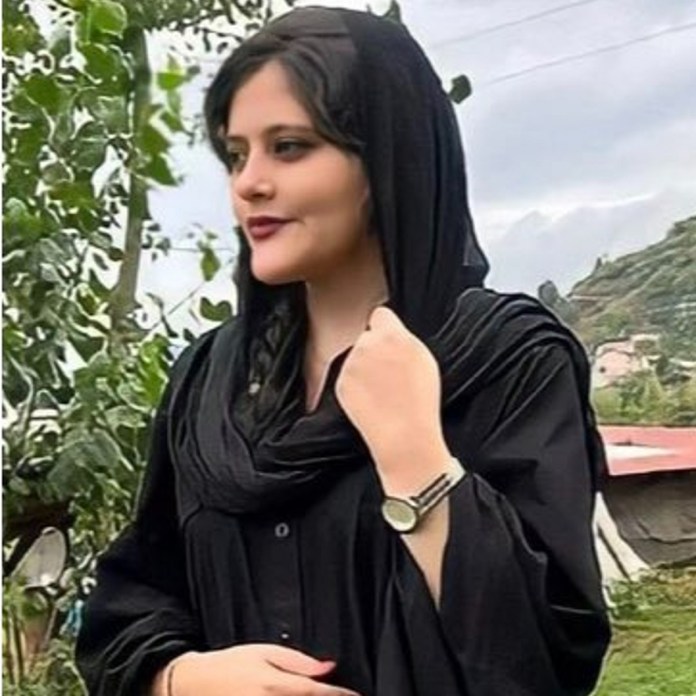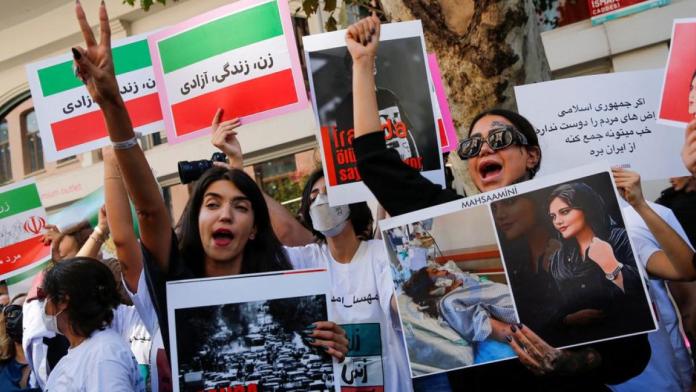While that has been the news for the past 4 h or so, the details of the decision of the Government of Iran suggest that it is nuanced. The rules of ‘morality’ stay; it’s the way to enforce the law that has been relaxed. Read on to know what exactly will become of what the West and modernists call the “morality police” of Iran.
Iran seems to have scrapped its morality police following more than two months of protests triggered by the arrest of a young woman, Mahsa Amini, for allegedly violating the country’s strict female dress code. All that she had done by way of violating the Islamic code of dressing was let a few strands of her hair peep out of her hijab. She died subsequently in police custody, triggering a nationwide protest by women of Iran supported by Western media commentary and worldwide condemnation by those who fashion themselves as modernists.

Women-led protests, branded as “riots” by the authorities, have swept Iran since the 22-year-old Iranian of Kurdish origin died on 16 September, three days after her arrest by the morality police in Tehran.
What exactly did the Government of Iran announce today?
While Attorney General of Iran Mohammad Jafar Montazeri was quoted as saying by the ISNA news agency that “morality police have nothing to do with the judiciary” and had been abolished, it was a comment made at a religious conference where he responded to a participant who inquired “why the morality police were being shut down”.
The official position was stated by President Ebrahim Raisi who said in televised comments yesterday that Iran’s republican and Islamic foundations were constitutionally entrenched “but there are methods of implementing the constitution that can be flexible”. That is not quite abolishing the controversial force.
The announcement of their abolition came a day after Montazeri said that “both parliament and the judiciary are working [on the issue]” of whether the law requiring women to cover their heads needs to be changed.
Distant history of Iran
During the Middle Ages, Turkic nomadic tribes from central Asia arrived. Historical evidence shows women did not wear headscarves back then. However, after the Safavid centralisation in the 16th century, the headscarf became defined as the standard headdress for many religious women in urban areas all around the Iranian Empire. Exceptions to this were seen only in the villages and among nomadic tribes, such as Qashqai.
Covering the whole face was rare among the Iranians and was mostly restricted to local Arabs and local Afghans. Later, during the economic crisis in the late 19th century under the Qajar dynasty, the poorest religious urban women could not afford headscarves.
20th century Iran
On 8 January 1936, Reza Shah issued a decree, Kashf-e hijab, banning all veils. The ban was left in place for a period of five years, from 1936 to 1941.
Official measures were relaxed in 1941 under Reza Shah’s successor, Mohammad Reza Pahlavi, and the wearing of a headscarf or chador was no longer an offence but was still considered an indicator of backwardness or of members of the lower class.
In the 1970s, the chador was usually a patterned or of a lighter colour such as white or beige; black chadors were typically reserved for mourning and only became more acceptable everyday wear starting in the mid-1970s — however in the period before the Iranian Revolution the black chador’s usage outside of the city of Qom was associated with allegiance with political Islam and was stigmatized by areas of Iranian society. Discrimination against women wearing the headscarf or chador occurred, with public institutions discouraging their use, and some eating establishments refusing to admit women who wore them.
Moral police since the 1979 Revolution
Then-President Mahmoud Ahmadinejad (tenure: 2005-13), an Islamic hardliner, had established the Gasht-e Ershad (Persian for “guidance patrol”) to “spread the culture of modesty and hijab”, the mandatory female head covering. Its units began patrols in 2006. But the force existed in other forms predating the term of Ahmadinejad.
Since the beginning of the revolution, the regime in Iran subjected women to harassment in public spaces because of the sartorial choices they made. Since 1979, the law asks women in Iran to wear a head covering.
Ahmadinejad merely turned moral policing more organised. The repressive nature of the administration in power and the general atmosphere of the political system influenced the harshness of the regime. According to Rad, “the Raisi administration has come in with a hardline view; Iran is already a country that has extreme social and political limitations, and… this administration wants to take it further,” said the report by Time (magazine).
The hijab became mandatory four years after the 1979 revolution that overthrew the US-backed monarchy and established the Islamic Republic of Iran. Morality police officers initially issued warnings before starting to crack down and arrest women 15 years ago. The vice squads were usually made up of men in green uniforms and women clad in black chadors, garments that cover their heads and upper bodies.
The role of the units evolved but remained controversial even among candidates running for the presidency.
Clothing norms gradually changed, especially under former moderate president Hassan Rouhani, when it became commonplace to see women in tight jeans with loose, colourful headscarves.
But in July this year his successor, the ultra-conservative Raisi, called for the mobilisation of “all state institutions to enforce the headscarf law.” At the time, Raisi charged that “the enemies of Iran and Islam have targeted the cultural and religious values of society by spreading corruption.”
Regardless, many women continued to bend the rules, letting their headscarves slip onto their shoulders or wearing tight-fitting pants, especially in major cities and towns.
Recent global backlash, 2017
In Iran, many women acted to transform the hijab by challenging the regime, subsequently reinventing culture and women’s identity within Iran. Iranian fashion designer Naghmeh Kiumarsi challenged the regime’s notion of culture through publicly designing, marketing, and selling clothing pieces that feature tight-fitting jeans, and a “skimpy” headscarf.
Kiumarsi is said to embody her own notion of culture and identity and utilise fashion to value the differences among Iranian women, as opposed to a single identity under the Islamic dress code and welcomes the evolution of Iranian culture with the emergence of new style choices and fashion trends.
Women’s resistance in Iran gained traction as an increasing number of women challenged the mandatory wearing of the hijab. Smith (2017) addressed the progress that Iranian women have made in her article, “Iran surprises by realizing Islamic dress code for women,” published by The Times (the UK).
The Government of Iran enforced their penal dress codes less strictly and instead of imprisonment as a punishment have implemented mandatory reform classes in the liberal capital, Tehran. General Hossein Rahimi, Tehran’s police chief stated, “Those who do not observe the Islamic dress code will no longer be taken to detention centres nor will judicial cases be filed against them” (Smith, 2017).
The remarks of Tehran’s recent police chief in 2017 reflected political progress in contrast with the remarks of Tehran’s 2006 police chief. Iranian women activists have made headway since 1979 relying on fashion to enact cultural and political change.
Critics of forcing women to wear a headscarf label this practice as Islamofascist.
On 27 December 2017, 31-year-old Vida Movahed, also known as “The Girl of Enghelab Street” was arrested for appearing unveiled in public after a video of the woman went viral on social media. The video showed Movahed silently waving her hijab, a white headscarf that she had removed from her head and placed on a stick for one hour on Enqelab Street, Tehran.
At first, it was assumed that her act was connected to the widespread protests taking place in Iran, but Movahed confirmed that she performed the act in support of the 2017 White Wednesday campaign. Vida’s arrest sparked outrage from social media, where many Iranians shared footage of her protest along with the hashtag “Where_Is_She”.
Women’s protests intensify, 2018
On 28 January 2018, Nasrin Sotoudeh, a renowned human rights lawyer, posted on Facebook that Vida had been released. It was not until a few weeks later that Sotoudeh revealed the girl’s identity. In the following weeks, multiple people re-enacted Vida’s public display of removing their hijabs and waving them in the air.
On 1 February 2018, the Iranian police released a statement saying that they had arrested 29 people, mostly women, for removing their headscarves, contrary to Iranian law. One woman, Shima Babaei, was arrested after removing her headdress in front of a court as a symbol of her continued dedication to the cause.
On 23 February 2018, Iranian Police released an official statement saying that any woman found protesting Iran’s compulsory veiling code would be charged with “inciting corruption and prostitution,” which carries a maximum sentence of 10 years in prison.
Before this change, Article 638 of the Islamic Penal Code of the Islamic Republic of Iran read as follows:
Anyone in public places and roads who openly commits a harām (sinful) act, in addition to the punishment provided for the act, shall be sentenced to two months imprisonment or up to 74 lashes; and if they commit an act that is not punishable but violates public prudency, they shall only be sentenced ten days to two months imprisonment or up to 74 lashes. Note: Women who appear in public places and roads without wearing an Islamic hijab, shall be sentenced to 10 days to two months imprisonment or a fine of five hundred to fifty thousand rials.
Following the announcement, multiple women reported being subjected to physical abuse by police following their arrests. Some have since been sentenced to multiple years in prison for their acts of defiance. In one video, a woman stands on top of a tall box, unveiled, waving her white scarf at passers-by. The video then shows a man in a police uniform tackling the woman to the ground.
Shortly after the video went viral, the Ministry of Interior (Iran) scolded police for using physical force against the woman. Salman Samani, a spokesman for Ministry released a statement on 25 February 2018 saying “No one has a license to act against the law even in the role of an officer dealing with crimes.”
On 8 March 2018, a video of three Iranian women singing a feminist fight song in Tehran’s subway went viral on. The women were singing in honour of International Women’s Day and to highlight women’s continued challenges caused by forced veiling and other discriminatory laws against women.
In the video, in which three bare-headed Iranian women sing “I am a Woman”, calls upon women to join efforts to fight injustice and create “another world” of “equality”. The women hold hands, display pictures of a previous women’s rights protest, and ask the other women on the subway train to clap in honour of “having lived and fought all their lives against all kinds of discrimination, violence, humiliation, and insults.” At the end of the video, one of the protestors is heard saying “Happy Women’s Day to all of you.”
The same day, the Supreme Leader of Iran, Ali Khamenei, made a speech during a gathering of religious poets in Tehran, posting a series of tweets in response to the series of peaceful hijab protests. Khamenei defended the dress code, praising Islam for keeping women “modest” and in their “defined roles” such as educators and mothers. He also lashed out at the Western world for, in his view, leading its own women astray. “The features of today’s Iranian woman include modesty, chastity, eminence, protecting herself from abuse by men,” Khamenei tweeted. He claimed that the most sought-after characteristic of a Western woman involve is her ability to physically attract men.
2022
Outside Iran, Melika Balali, an Iranian-Scottish wrestler, became the British champion in June 2022, she protested in the match against compulsory hijab by rising a sign which wrote on it “Stop forcing hijab, I have the right to be a wrestler”.
The Iranian protests against compulsory hijab continued into the September 2022 Iranian protests which was triggered in response to the killing of Mahsa Amini, who was allegedly beaten to death by police due to wearing an “improper hijab”.



You must log in to post a comment.